2004
-
I have my entire music collection, some 600+ CDs, stored as MP3 files on my network and use it all the time. (And I’m not talking 128kb MP3 here, I’m talking lame -alt-preset insane.
-
I have been taking digital photos now for 5 years and it’s starting to take up real space. And similar to the music, my new Canon Digital Rebel is taking 7-10MB per raw image.
-
Most importantly, it seems that it’s relatively easy now and I wanted to try it. (This is where I was wrong.)
Edina Art Fair
Tammy and I went to the Edina Art Fair today. The fair is bigger than it has been in recent years. The quality of the art was both better and worse. We were excited to see the Yardbirds there (we have a few of their things) and we couldn’t help but get a picture from one of the local artists that we thought was very cool (picture below). However, there were a couple of stands that were terrible. We couldn’t figure out how they had gotten in through the judges. One was selling stuffed snakes from Taiwan!
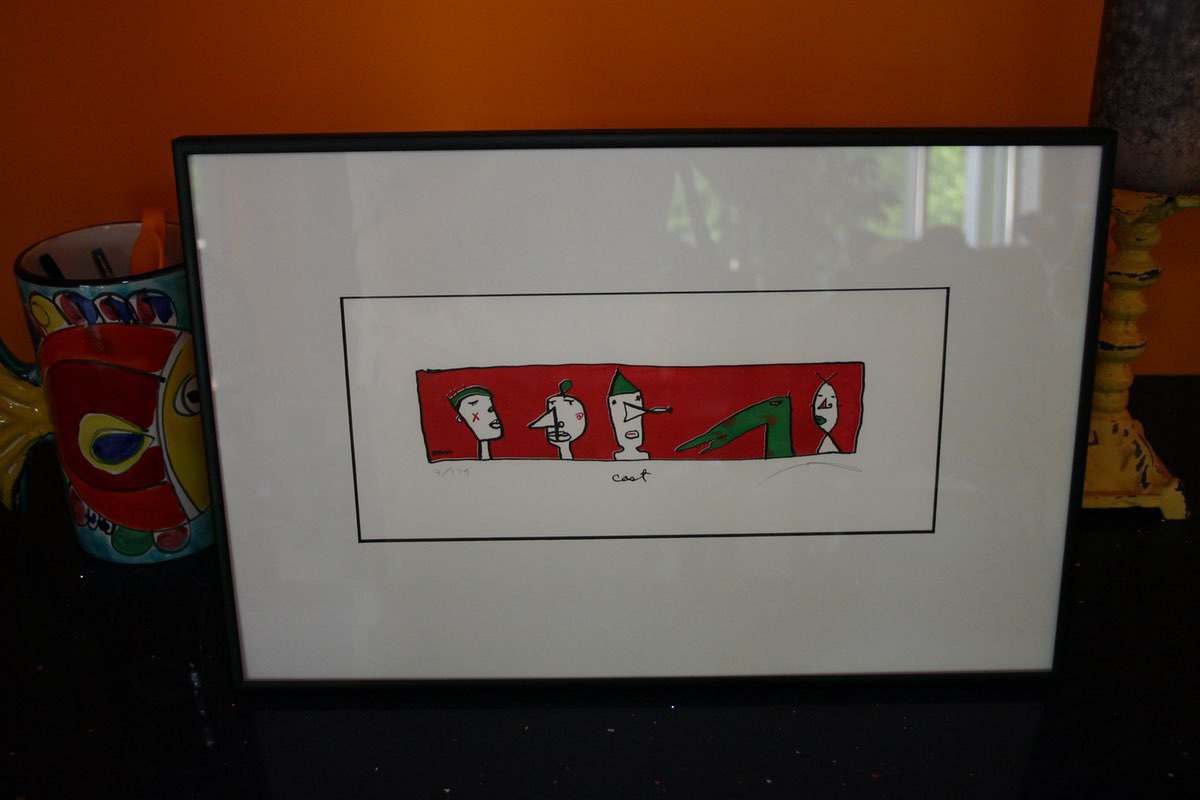
The weather was great, if not a bit too hot.
House Painted
Our house is finally done getting painted. Everything is back where it belongs. Yeah!
Apple Duathlon!
I’m exhausted!
Tammy and I completed our very first multi-sport event. We did the Apple Duathlon in Sartell, MN today. A duathlon for those of you that are not aware is one less than a triathlon (imagine that!). It only involves running and cycling. However, to keep it interesting you still do three sessions which are typically a run, then bike, then run again. This duathlon was a 5k run followed by a 20 mile cycle finished with another 5k run.
I’ve done plenty of running races before. I’ve also done my share of cycling races. But putting them together with the transition area and such was very new. The duathlon was extremely well run and if you are interested in these kind of events I highly recommend it. The staff did a great job. The race hosted everyone from elite male/female racers to two gentlemen over 70! They even had an Athena/Clydesdale division - I raced in the Clydesdale division. These divisions are for bigger people. Athena is for women over 150 pounds and Clydesdale is for men over 200 pounds. I’ve always wanted to do a race with a Clydesdale division so that was fun. The race is USAT certified and is the longest running multi-sport event in Minnesota. It was also fun to get marked up triathlon style. There is no guessing about ages at these events – it’s in marker right on your leg!
The race took off in 6 waves, separated by 3 minutes. The elite athletes went first of course. Tammy went in wave 5 and I left in wave 6. I started three minutes behind her on the road.
Tammy set a new personal best on the first 5k. I came in a minute after her. Tammy has developed really good running form and I’m finding it hard to keep her pace. I hope to remedy that shortly. 🙂 On the bike I made up the gap and actually caught up and passed her, taking the 3 minute start lead she had away.
The transition from the first 5k to the cycling wasn’t too bad. Tammy and I both felt pretty strong. However, after pedaling for an hour at an all out pace (my average speed was just under 20 miles, and that was with some hills) my quads were absolutely killing me. I can’t quite explain the sensation of getting off the bike and then starting another 5k. A lot of interesting thoughts went through my head. I actually at one point on the cycling leg, when my legs were really hurting, thought it would be really nice if I could just have a flat right then. My wish wasn’t answered.
I about died on that last 5k, my time was horrible and I gave all the time that I had gained on Tammy back to her. (No, we aren’t competitive at all.) I ended up barely finishing ahead by about 20 seconds. Feel free to check out the complete race results.
We both had a good time (sick, I know) and I doubt this will be our last multi-sport event. Tammy absolutely loved it and is already making plans to come back next year!
Couple photos from before the race are here.
House Painting nearly complete
At this very moment the painters are removing the plastic covering from all the windows in our house. We can see again! It’s amazing how odd your house feels when all of a sudden the windows are all opaque and you cannot see out. It’s like living in a sensory deprivation chamber (okay, it’s not that bad but it was annoying).
For some reason the garage door is having a terrible time opening. It is behaving like it weighs a thousand pounds more than it did before.
Go California
The People’s Republic of California is an interesting state. While there are many referendums and interesting progressive groups in the state that sometimes make no sense to me, I was excited to see the state fighting what I feel is the good fight on two fronts.
California communities have actually been fighting off the WalMart takeover of the country. Hat’s off to them for not welcoming such a scavenger business into their economies.
Also, I just found out about Senate Bill 19 in California that mandates certain qualities of food given to kids in public schools. I’d love to see how few McDonalds menu items would be allowed under this.
Expose of the Hot Air Balloon Industry
I’m sitting on a huge story and I think I should be calling our headline desk to break it. There is a scam going on, a big scam, on people looking for an enjoyable adventure into the air on a hot air balloon ride. I’m sure you’ve probably seen a picturesque hot air balloon over some vacation town at some point. It’s a wonderful experience – but I’m here to tell you it’s a big scam.
Here is how the scam works. First, you need to purchase your ticket to ride the balloon of course. This seems straightforward enough. However, the trick is that the weather must be nearly perfect in order to actually launch the balloon. Seriously, if the trees are moving, forget about it. So, they get your money and then for years you work to schedule a flight and then it’s canceled. You schedule again, only to get canceled. This will happen over and over again, all the while they are sitting on your money. No doubt it is being used in some racketeering operation or other illicit purpose.
All the while you, the poor consumer in this scam, is left essentially hopeless. What do you know about flying a hot air balloon? Nothing! Even if the weather is completely still on the ground, they will tell you it’s terrible a couple thousand feet up. Do you want to go up and die in some storm after all?
The Hot Air Balloon industry must be held accountable for these wrong-doings against the American consumer. Let’s break this story wide open!
Project Terabyte!
A couple of months ago, not that long after I decided I needed gigabit networking at home, I decided that I also needed a terabyte of storage at home. My reasons for this were:
When we remove limitations from systems it is amazing to me what we discover we are able to do. Given more processor, we find ways to use it. Given more bandwidth, it gets used. Applications march onward. And I’m curious to consider the applications possible if we can assume that every household has a terabyte of disk just sitting there. I actually believe strongly that an industry will form around this concept, but that is another posting for another day. Back to my Geek Fest.
I started this Geek Fest as many are started with too little information and a bliss that it would just be easy (as a friend of mine joked, “just like every other IT project eh?”). I wanted a terabyte of storage and it needed to be RAID. I also decided that PATA would not be acceptable, I wanted SATA. After looking around I decided there was a clear winning combination for me in the 3ware Escalade 8506-8 card combined with 6 Western Digital 200GB SATA drives.
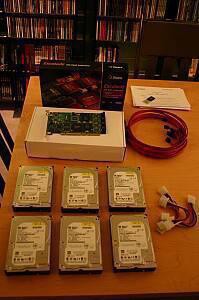
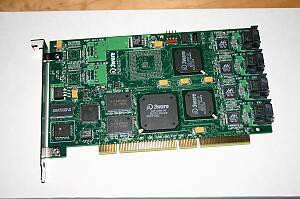
I ordered this up and waited for it to arrive thinking how easy this will be and why doesn’t everyone have this stuff!? This is when my hubris was revealed.
I got the equipment and I knew that mounting it in the case was going to be a challenge. But when I grabbed the Escalade card I saw an immediate problem, the slots didn’t match up. Yes, I had purchased a PCI 64-bit 66 Mhz card and my reasonable motherboard only had PCI 32-bit 33 Mhz. This was minor hiccup number one.
I started to look high and low for a solution but there are very few motherboards with PCI 64-bit 66 Mhz interfaces that are not server boards (there are a handful of 33 Mhz ones). All of a sudden I found myself facing a new motherboard, err, server board and to add some joy to the situation none of these boards took a P4 CPU, they were all Xeon, in fact, even better, they were all dual Xeon (yes, I realize you can just put one in, but it’s not as cool!).
I sat on this for a couple hours as I debated and tried to decide how to convince my wife that in addition to the Escalade and the drives I now needed a new motherboard and a CPU, or two!
I decided to go all the way with this project and for the first time I was going to build a real server for home. None of this leftover desktop server, this was going to be a machine I could use for the next 3 years (or so I told my wife!). I decided that I would go with the Asus PU-DL motherboard and trick it out with 1GB of ECC RAM and two (what the heck!) Xeons at 2.4 Ghz. One of the selling points was the dual Gb ethernet on-board, including one of the ports which has a PCI-X 133 Mhz connection so I could actually transmit a full Gbps. Not to mention hyper-threading support so Windows would see 4 CPUs. This thing was going to scream. I was wary of one issue, the case. So I assured myself this was going to be fine since this was an EATX motherboard and my Antec case supports EATX form factors. Or so I thought…
This introduced minor hiccup number two. I eyed out the motherboard and it seemed like it would fit and indeed (however it sure had acreage!), it seemed to be okay. However, the dual Xeons which stand almost 5 inches off the board were in the way of the drive bays! To add further insult, it turns out my new server board requires a 24 pin ATX power supply connection and that great new 12V connector that came with the P4? Well, I need an 8pin version of that for the dual CPUs. I went to literally every mom and pop techie shop in town looking for cases and came up totally dry.
I did some searching online and I realized that I was going to need to make yet another investment in my Geek Fest, a new case. Now, cases are supposed to be simple, but not for this project. I ended up going with a SuperMicro SC742T-550 Chassis. While I wasn’t anticipating this, I have to admit I’m pleased that I went with this chassis. It was more money than I would have liked, but the integrated SATA hot-swap bays and the rack-mount capability is a nice thing to have in the future.
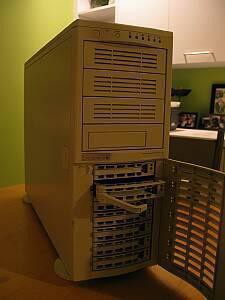
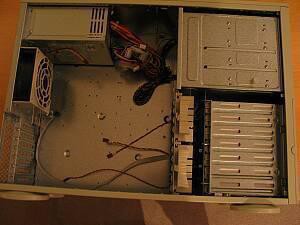
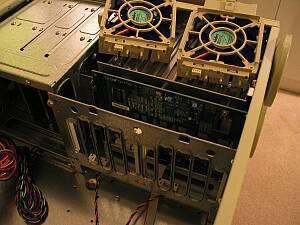
Just when you think my story is going to come to an end, along comes minor hiccup number three. I got the new case, sniffed it and took it to my waiting motherboard and drives. Now, I’ve built my share of machines and I have to admit this is the first time I’ve ever really felt over my head. Dealing with the cabling, all the cooling, the crazy jumpers on the server board was all a bit much. This wasn’t your standard gamer box being put together. It gave me some renewed appreciation for the internal design that goes into those crazy 1U servers we buy.
Let me take a moment to talk about the processors. Mounting Xeons is an interesting chore. The chip requires you to bolt it’s cooling assembly all the way through to the case because it is too heavy for just the motherboard. The heatsink is gigantic, and it comes with a plastic enclosure that makes the air more efficient as it goes over it. Pretty impressive. Asus also gave their own cooling assemblies that would have been easier to work with the motherboard, but they were noticeably smaller than the Intel ones so I opted for the OEM parts.
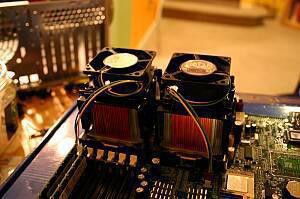
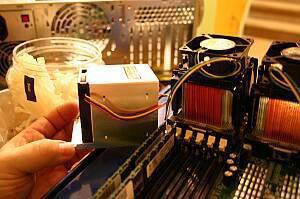
After a few hours (really!) of getting everything right. I was ready to experience the magic. However, my wonderful 24pin ATX power connectors and 8pin CPU connector was 6 inches too short! I couldn’t plug them in! Aargh!
So now starts minor hiccup number four. I needed to find extension cables to get these things to the server board. I searched and found a ton of 24pin to 20pin adapters. But found very few 24pin extenders. I finally found some online and was confused to find “orange cables” and “green cables”. I figured this was up there with the glow-in-the-dark cables and fans with LEDs on them and just ordered the orange ones and thought nothing of it. To my great discontent I found out that orange and green indicate different power standards (link courtesy Chris Tersteeg)! The machine wouldn’t power up when I connected it and when I inspected the cables I found the 24pin extension wasn’t a straight-through. Wires were going every which way and some didn’t go through at all!
I called the company and did some more research and found I just needed a straight through. They sent me that instead while I worried that I had fried my server board with the wrong power connector. Our story however ends with a happy ending as I plugged in the extender and the server roared (literally! 4 fans and 7 hard drives!) to life.
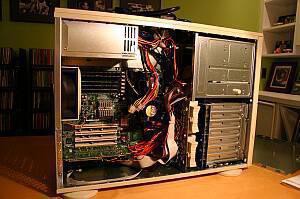
It’s been running now for a couple of weeks. I’ve got 1.4 terabyte of disk in it formatted out in different ways to around 1 terabyte of usable storage. Everything has been working awesome and the RAID is performing great. The verdict of my project though is that a terabyte isn’t reasonable yet for the average home user. However, I still think it will be there in say, 2 years.
Got Gig?
A couple weeks ago I made the big jump to GigE at home. Why have gigabit ethernet at home? Why not!
The first step to this Geek Fest was to figure out what was needed. Chris Tersteeg gave me a quick download on the marketplace (what is it with him and this type of information?!) and I did some research on my own as well. To be elite you really need to have jumbo frame support on your gigabit gear.
What is jumbo frame support you ask? Well, in a normal or fast ethernet network your frame size is pretty small, 1,500 bytes. So everything you send is chunked down into frames of 1,500 bytes. To send 1MB of data requires 700 frames. Well, with gigabit you are going to break things down into a lot of frames. To make life more manageable you can enable jumbo frames. This allows you to increase your frame size to values like 9,000 bytes. This makes that 1MB of data only require 117 frames! You can do the math, 1/6th the number of frames and hence fewer interrupts and the like on the network. Theoretically, faster throughput (hmmm, or not, see iperf results below).
I settled on the SMC 8508T which brings 8 ports of full gigabit and support for jumbo frames. This is the only switch in the sub-$150 range with jumbo frames. I then opted for the high-end and went with the Intel Pro/1000MT gigabit cards. These also support jumbo frames (need that on both the server and the workstation) and have good drivers.
One of the fun things about gigabit is that you don’t have to worry about duplex. It’s just handled automagically. Other than that, everything is pretty much the same.
So, how does it perform? The following tests were all done using iperf.
| Configuration | Test 1 | Test 2 |
|---|---|---|
| No Jumbo Frames | Up 515 Mbps / Down 611 Mbps | Up 510 Mbps / Down 612 Mbps |
| 4,088 bytes Jumbo Frames | Up 499 Mbps / Down 650 Mbps | Up 525 Mbps / Down 704 Mbps |
| 9,014 bytes Jumbo Frames | Up 596 Mbps / Down 540 Mbps | Up 599 Mbps / Down 506 Mbps |
Note, the Intel Pro/1000MT supports frame sizes up to 16,000 bytes! However, when I used these iperf kept on crashing on me when I did the test. Note, the SMC 8508T only supports up to 9000 bytes frames so not sure what happens when you try to send frames larger than the switch supports.
The performance is a little puzzling. Hard to identify any real patterns, and the asymmetry makes no sense. To add even more confusion to it, the performance advantage flip-flops between 4,088 byte frames and 9,014 byte frames. I’ve left my system using 4,088 byte frames for now, but haven’t had the time to really dig into what is going on on the wire here.
The end result is a blazing fast home network backbone. The realistic application of this is that network disk performance is almost as fast as local disk performance. So doing image manipulaton of MP3 management over the network is much more realistic.
All of this performance, and the total cost to do this Geek Fest was around $220. It’s amazing to me how far your dollar goes when buying gear these days!
The next Geek Fest will be the installation of over a terabyte of disk in the home server. Stay tuned!